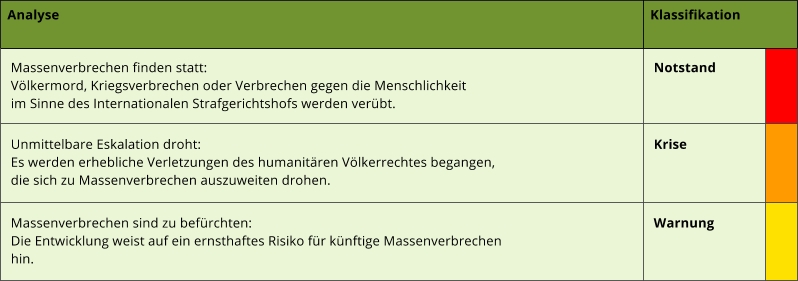[i] Die Definition folgt einer Empfehlung von Scott, Straus 2011: Identifying genocide and related forms of mass atrocities, United States Holocaust Memorial Museum, Working Paper, S. 21, auf: http://www.ushmm.org/m/pdfs/20111219-identifying-genocide-and-mass-atrocity-strauss.pdf; zuletzt abgerufen am: 01.02.2015.
[ii] Genocide Alert betreibt zur Information über die Schutzverantwortung (engl. Responsibility to Protect) ein Informationsportal auf Schutzverantwortung.de. Zur Definition der Schutzverantwortung siehe: Was ist die Schutzverantwortung oder „Responsibility to Protect“?, auf: www.schutzverantwortung.de/schutzverantwortung-/was-ist-rtop/index.html; zuletzt abgerufen am: 01.02.2015.
[iii] Zur Diskussion von Definitionen und Schwellenwerte von Massenverbrechen siehe: Scott, Straus 2011: Identifying genocide and related forms of mass atrocities, United States Holocaust Memorial Museum, Working Paper, auf: http://www.ushmm.org/m/pdfs/20111219-identifying-genocide-and-mass-atrocity-strauss.pdf; zuletzt abgerufen am: 01.02.2015.
[iv] Valentino, Benjamin 2004. Final Solutions: Mass Killing and Genocide in the Twentieth Century, Cornell University Press, London.
[v] Ulfelder, Jay/Valentino, Benjamin 2008. Assessing the Risks of State-Sponsored Mass Killing, Political Instability Task Force, Washington, DC.
[vi] R2P Monitor des Global Centre fort he Responsibility to Protect, auf: http://www.globalr2p.org/our_work/r2p_monitor; zuletzt abrufen am: 01.02.2015.
[vii] Early Warning Project, auf: http://www.earlywarningproject.com/; zuletzt abgerufen am: 01.02.2015.
[viii] Das u.a. von Yehuda Bauer und Barbara Harff initiierte Genocide Prevention Advisory Network ist eine informelle Gruppe von Experten ohne feste Mitarbeiter, deren Mitglieder politische Risikoanalyse für Massenverbrechen anbieten. Ihre Internetseite ist zu finden auf: http://www.gpanet.org/; zuletzt abgerufen am: 01.02.2015.
[ix] Bellamy, Alex J. 2011: Mass Atrocities and Armed Conflict: Links, Distinctions, and Implications for the Responsibility to Protect, S. 9, The Stanley Foundation, Policy Analysis Brief, auf: http://www.stanleyfoundation.org/publications/pab/BellamyPAB22011.pdf; zuletzt abgerufen am 01.02.2015.
[x] Harff, Barbara 2009: How to Use Global Risk Assessments to Anticipate and Prevent Genocide, in: Politorbis 47 (2), S. 71-79.
[xi] Bellamy, Alex J. 2011: Mass Atrocities and Armed Conflict: Links, Distinctions, and Implications for the Responsibility to Protect, S. 10, The Stanley Foundation, Policy Analysis Brief, auf: http://www.stanleyfoundation.org/publications/pab/BellamyPAB22011.pdf; zuletzt abgerufen am 01.02.2015.
[xii] U.S. Army Peacekeeping and Stability Operations Institute 2012: MAPRO – Mass Atrocitiy Prevention and Response Options. A Policy Planning Handbook, Carlisle, Pennsylvania, S. 13.
[xiii] Ruben, Reike/Sharma, Serena/Welsh, Jennifer 2013: “A Strategic Framework for Mass Atrocity Prevention”, Oxford Institute for Ethics, Law and Armed Conflict, Paper 03/2013.
[xiv] United Nations 2014: Framework of Analysis for ATROCITY CRIMES. A tool for prevention, auf: http://www.un.org/en/preventgenocide/adviser/pdf/framework%20of%20analysis%20for%20atrocity%20crimes_en.pdf; zuletzt abgerufen am: 01.02.2015.
[xv] U.S. Army Peacekeeping and Stability Operations Institute 2012: MAPRO – Mass Atrocitiy Prevention and Response Options. A Policy Planning Handbook, Carlisle, Pennsylvania, S. 13.

